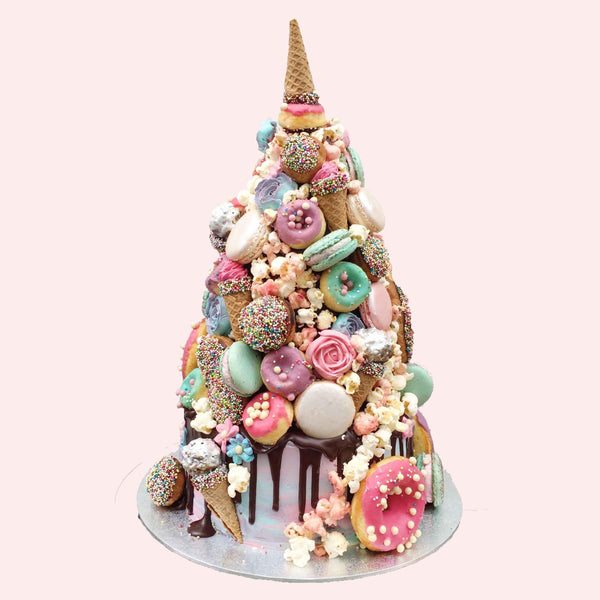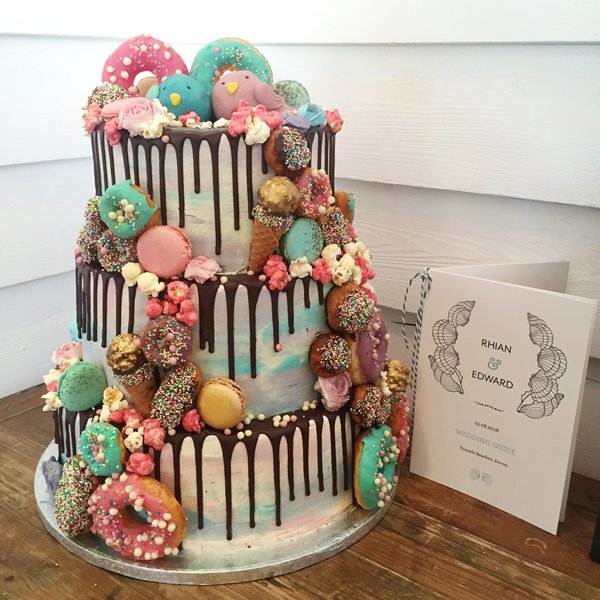
Wedding cakes as we know them are created by the bakers of today standing on the shoulders of innovative bakers throughout the ages muddled in with thousands of years of cultural traditions. While the wedding cake has evolved and transitioned to something extremely different from its earliest forms, they fundamentally remain the same: they are to be eaten and celebrate a marriage.
The Wedding Cake is largely viewed as a quirky English development. Montagne’ in his very famous Gastronomique aptly described the Wedding Cake as an English plum cake and as ‘a monumental cake’ which is ‘a symbol rather than a delicacy, a tradition handed down from one century to the next, whose origins are lost in the mists of antiquity'. In nearly all countries that celebrate a wedding with a cake the English Wedding Cake dominates. Continental Europeans however favoured a much lighter cake such as a croquembouche - a cone of small round choux pastries aka profiteroles covered in toffee sauce - or a set of light sponge cakes decorated with cream or icing with other sweet items such as macarons.
It’s true wedding cakes have absolutely nothing in common with the ‘cakes’ used during Roman Wedding Celebrations. The confusion may have arisen from J.C. Jeaffreson’s book Brides and Bridals (1872) in which he told the story of an ancient Roman marriage practise involving the breaking of a ‘cake’ over the bride’s head. He took the Roman definition of a cake – which was basically a biscuit – and leapfrogged past a thousand years of history and concluded this was the same as serving an actual wedding cake integral to the wedding ceremony. To be fair, it wasn’t uncommon for authors from the same period to imaginatively link events and items back to Ancient Roman times in an attempt to validate their significance.
During Medieval England the cakes of today did not exist – a biscuit is not a cake! And the Medieval period lasted a thousand years so isn’t particularly informative. Similarly, icing was not yet being invented until the 16th Century. While feasts did happen at the same time as weddings there is no identified reference to a special type of food whatsoever being commonly served or any ritual revolving around any type of food item. Jeaffreson again misleads the reader into thinking there was some connection in what is presumably an attempt to justify their origin in Roman times. The only genuine connection is that the feasts provided a platform for the wedding cake to evolve.
One of earliest references to cake (not in its present form) being part of weddings is from the Church. During the sixteenth century after Sunday Mass, bread would be blessed and given out. This custom was then carried forward to weddings. In Thomas Deloney's The Pleasant History of John Winchcombe, Deloney describes Winchcombe’s wedding around 1513 with his bride’s procession as having “all the chiefest maydens of the Country, some bearing great Bride Cakes, and some Garlands of wheate finely gilded.” While cake at Church didn’t continue for long, cake began to be integrated to the wedding ceremony. Stacked cakes or tiered cakes were referred to as early as 1580, named “Great cakes.” Elaborate wedding cakes developed as they travelled their way up to the upper echelons of society. Inevitably the cakes needed to become sufficiently special to grace a special occasion like a wedding.
The earliest official wedding cake recipe was published in 1655 by Price (1655) in The Compleat Cook (yep spelt correctly). The ingredients used were: A peck (6.5kg) of Fine flour, ½ ounce of large Mace, ½ ounce Nutmegs, ½ ounce Cinnamon, 2 pounds of Butter, 6 Eggs, pint of Ale-yeast, 10 pounds of currants, a little Musk and Ambergreece dissolved in Rosewater for the cloth.
During the same period wedding cakes made with almonds and spices began to appear in recipes suggesting a degree of popularity. On occasion they were referred to as ‘bride cakes.’ By the 18th Century and during their rise in popularity they became commonly known as plum cakes. The 18th Century also saw the recipe evolve to become richer primarily by using less flour. As the century progressed the recipe began to include currants, raisins and candied citrus fruits. In the 19th Century these ingredients became the norm along with Jamaican Rum. The early part of 20th Century saw the addition of sultanas and glace cherries. During the reminder of the 20th Century the recipe largely remained the same although the proportion of the ingredients changed quite significantly to reach today's modern recipe. Up until approximately 1980 most recipes were based on this traditional recipe. In 2016, wedding cakes are frequently made with regular cake sponges which are preferred by the modern palate.
As mentioned, Wedding Cakes started to appear in the 16th Century. From the 16th Century until the middle of the 19th Century their popularity steadily rose. During the later 19th Century they experienced a major jump in popularity; a wedding cake became the flagship product of the confectionery trade with bakers windows filled with them. At the same time more affordable and smaller wedding cakes were developed further fuelling their popularity. As they became ever more popular the names ‘plum cake’ and ‘bride cake’ began to be widely replaced with “wedding cake.” During the 20th Century commercial production techniques saw the recipes become more complex while using a cheaper ingredient mix. Around 1930 wedding cakes entered the realm of home bakers while becoming more affordable. This along with other indirect factors caused another a jump in popularity. Similarly in the 1980s wedding cakes experienced another rise in popularity when the wedding industry was established. In 2016 Wedding Cakes seem to be experiencing a somewhat of a resurgence with many couple moving away from the traditional cake and opting for something more tasty!

The basic decorative features of wedding cakes can be traced back to the development of sugar paste. During the 16th Century the French developed sugar paste for decorative purposes and used it to create grand sculptures for high society. It was used in Italy but in England and London it was the development of icing – namely Royal Icing - that was the choice of bakers. First made in the 15th Century it became popular on wedding cakes in the 18th Century when there was a period of experimentation and development and it was invented. Fondant icing started to appear in recipes but only very infrequently, it wasn't until the 19th Century that Fondant icing became popular and remains today.
During the 16th and 17th centuries, it was bride pies, not cakes, that were most popular at wedding feasts. Some recipes, like Thomas Dawson’s "Tarte that is a courage to a man or woman" from 1596/7, included ingredients believed to have aphrodisiac properties, such as sweet potatoes and cock sparrow brains. Other bride pies were far more elaborate, containing a variety of fillings from prawns and oysters to lambs’ testicles and artichokes, sometimes with a live bird or snake in the center for entertainment. This tradition of bride pies continued into the 18th century, though their fillings became more akin to that of a minced pie.
Alongside bride pies, 'bride cakes' were also made. These early forms of wedding cakes were more like sweet yeasted breads with fruits and spices. Over time, enriched yeast cakes evolved into the plum cakes or fruit cakes we know today, often glazed with sugar icing. The tradition of icing a bride cake with almond paste and sugar icing dates back to the 18th century, setting the stage for the extravagant decorations seen in later years.
By the 19th century, wedding cakes became large, single plum cakes with elaborate decorations. The wedding cake of Queen Victoria and Prince Albert, for example, weighed 300 lbs and featured detailed decorations symbolizing fidelity and love. This era saw the introduction of tiered cakes, with the top tiers sometimes made from sugar sculptures rather than cake. The trend of grand wedding cakes continued, with Queen Elizabeth II’s wedding cake in 1947 being nicknamed ‘The 10,000 Mile Cake’ due to its ingredients being flown in from around the commonwealth.
Initially a luxury for the wealthy, more affordable versions of wedding cakes became available towards the end of the 19th century. The 20th century saw further adaptations to reduce costs, such as substituting expensive ingredients. During World War II, inventive solutions like elaborately decorated cardboard cakes became popular. Today, the preference has shifted towards lighter sponge cakes, often served without icing, reflecting the changing tastes and trends over time.
This Georgian recipe, adapted for modern baking, reflects the rich flavor of traditional wedding cakes with brandy, fruit, and nuts. Although originally much larger, this version serves around 20, making it perfect for a wedding or a delightful treat with tea.
For those inspired by the rich history of wedding cakes and culinary traditions, visiting historical kitchens offers a unique glimpse into the past. From the Victorian kitchen at Audley End House to the Swiss Cottage kitchen at Osborne, these sites provide a fascinating look at historical cooking practices.
Academic studies and historical documents on the cultural practices surrounding weddings often touch upon the evolution of wedding cakes as part of the larger discussion on marriage rituals. For instance, research into European marriage customs can provide insights into how wedding cakes, originally simple breads, evolved into complex symbols of fertility, prosperity, and community sharing (Wilson, 2005). Comparative studies of culinary traditions across Europe may highlight the distinct evolution of wedding cakes in England versus the lighter, confectionary preferences seen in continental Europe (Smith, 2010). These works could explore how English plum cakes became emblematic of wedding celebrations, diverging from the pastry-based traditions seen in France and Italy.
Culinary history texts, such as those documenting the history of English baking, might provide references to historical wedding cake recipes, including the transition from fruit and nut-based compositions to the modern preference for sponge cakes (Davidson & Jaine, 2006). Documentation of royal weddings and their impact on popular wedding traditions can support the discussion on the role of wedding cakes in symbolizing union and prosperity. The wedding cakes of Queen Victoria and Queen Elizabeth II, for example, are often cited in discussions of how royal preferences influenced public tastes (Avey, 2012).
Studies in contemporary culinary trends might offer insights into the shift towards more diverse and personalized wedding cakes, reflecting broader societal changes in taste, dietary preferences, and the significance of marriage ceremonies (Turner, 2018).